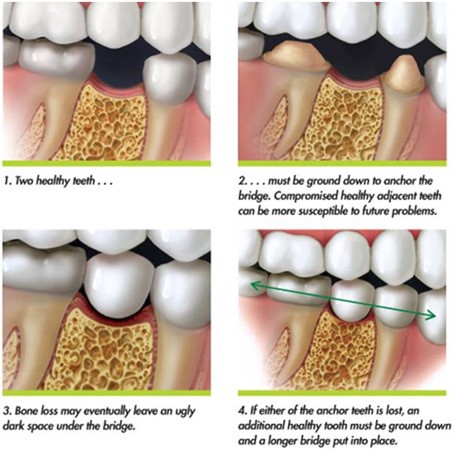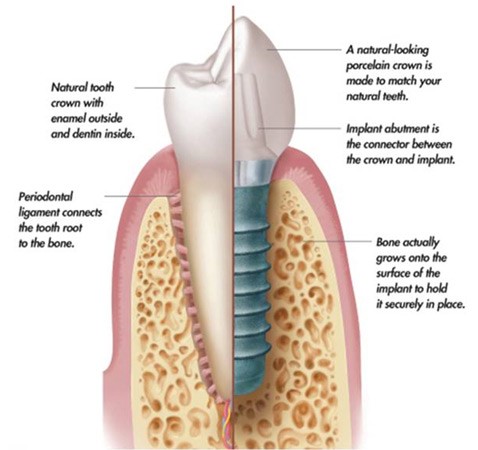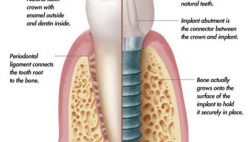LIGHTWALKER LASER
Bone graft for dental implants
For those who are missing one or more teeth, the cosmetic effect of a dental implant is almost unbeatable. Dental implants look and function the same as a regular tooth, and a successful implant is just about undetectable. It is always important, however, to make sure that you understand all the various aspects of an oral surgery, and dental implants are no different. One of the main things to be aware of is the possibility of needing a bone graft for dental implants.

Bone grafting
A dental implant basically has two pieces: a metal cylinder that is placed into the jaw bone and functions like the root of the tooth, and an abutment that screws into the first piece. A crown is then placed on the abutment, creating the appearance of a tooth.
The oral surgeon may talk to you about undergoing a bone graft for dental implants if he believes that your jaw bone is too thin or soft to keep the implant in place in its current state. If the bone cannot support the implant, it may cause the implant surgery to fail.
In a bone graft procedure, the surgeon will take a section of bone from another area of your body, or – as is most often the case now – use a special bone grafting material, and graft it onto your jaw bone. You will then have to wait, most likely several months, while the graft creates enough new, strong bone to make sure that the implant will be stable and secure. It is possible if you only need a minor graft that the procedure might be able to be done at the same time as the implant surgery, but your dental specialist will make the final decision. A successful bone graft allows your jaw bone to be strong enough to support your dental implant.

Once the bone graft is complete, the rest of the implant surgery can proceed. As with any surgical procedure, it is important to discuss your personal medical history and all the risks and benefits of the surgery with your dental specialist. Once your doctor decides you are a good fit for the procedure, you can look forward to a brand new smile.

- Published in Dental Implant, Tin tức
Dental implants
At DR.BEAM Dental Clinic, we have found that dental implants are truly able to enhance the quality of life for our patients. Dental implants can improve our patients’ overall health, while helping them gain the confidence that comes from a well-functioning smile that looks good and feels natural.
There are many benefits to replacing missing teeth with dental implants, mainly they:
• Maintain the integrity of bone structure after tooth loss
• Preserve the health of adjacent teeth, since there is no need for bridgework
• Replace loose-fitting dentures
• Distribute bite forces evenly throughout the mouth
• Function and feel like natural teeth
• Improve speaking ability when bulky dentures are eliminated
• Improve facial appearance by preventing bone loss
Why Dental Implants?
Losing a tooth can be devastating, not only because it affects the way you look, but also because it can lead to other physical problems that may affect your health and prevent you from smiling with confidence. It is vitally important to replace missing teeth with dental implants promptly in order to prevent health consequences such as:
• Bone loss
• Shifting and drifting of the teeth
• Alteration in the bite as a result of shifting teeth
• Jaw joint problems
• Difficulty in chewing properly
• Additional stress on the remaining teeth
Bridges vs. Implants
For many patients in our clinic, dental implants offer clear advantages over traditional bridgework or dentures. Before dental implants were perfected, in order to replace missing teeth we had to fashion tooth-supported bridges or removable dentures.
With bridges, healthy tooth structure had to be ground away by reshaping neighboring teeth, which allowed us to use them as supports for anchoring the new bridge. Unfortunately, these support teeth would be subjected to forces beyond their threshold, so the bone surrounding these teeth would begin to melt away and resorb, thus weakening their natural support system.
Esthetically, dark shadows would appear around the bridge as the bone and gum began to pull away from the support teeth. There was also an additional risk that the pressure on the bridge could open up a gap between the tooth and the bridge, forcing bacteria leakage and decay and leading to the possibility of root canals. What’s more, bridges connecting three or more teeth together made flossing difficult or impossible for patients.

The psychological effects of tooth loss are complex and are different for everyone. A person’s social life may be severely affected to the point that they will avoid romantic situations for fear their partner will discover the tooth loss. If there is severe bone loss after multiple teeth have been missing for years, facial disfigurement will occur, often accompanied by the appearance of premature aging.
While dentures can give a sense of esthetic security, they can also cause damage by placing excessive forces on the underlying bone structure, leading to bone loss. Eventually, the dentures will need relining or complete replacement. All of these problems can be prevented with dental implants.

What Are Dental Implants?
Dental implants are biocompatible titanium replacements of the tooth’s anchoring roots. Dental implants replace missing teeth by mimicking nature as closely as possible.
At DR.BEAM, dental implant restorations have three parts:
• Titanium, bone-integrated implant
• Implant abutment
• Implant porcelain crown
Let’s look at a cross section of tooth and an implant together to visualize what a dental implant can provide.

What Brand of Dental Implant Do We Use?
There are literally hundreds of dental implant companies, and all have their benefits. In DR.BEAM, we use various dental implant brands that best fit our patients’ dental and financial conditions.
With our team’s implant specialists, we provide our dental implant patients with functional, esthetic and long-term success of nearly 100%.
What Is the Dental Implant Placement Process?
• Planning stage: Planning is the most important part of the process. A carefully and intelligently thought-out treatment plan is the difference between success and failure. Sometimes we may require specialized imaging to visualize the bone condition and three-dimensional viewing to ensure proper placement.
• Implant placement: our implant specialist will place the dental implant in the ideal spot to form the gum tissue around the implant.
• Healing: the bone around the dental implant will grow and integrate with the new implant in a matter of a few weeks.
• Temporary restoration: if the dental implant is in a readily visible area, a temporary restoration may be placed for esthetic purposes while the site heals.
• Abutment placement: when healing is complete, the dental implant abutment is placed to connect the dental implant to the porcelain crown.
• Porcelain crown: once our ceramist fabricates the new porcelain crown to exact specifications, we bond the crown to the abutment.
Can Anyone Get Dental Implants?
Anyone with missing teeth is a candidate for dental implants. It does not matter how old you are, but it does matter how young. It is inadvisable to place dental implants during in the early teen years, since the dental and facial bones are still forming at that age.
The best time to place a dental implant is at time of tooth extraction, or shortly thereafter. However, we have placed dental implants successfully years after tooth loss. What’s important is the presence of an adequate amount of healthy bone to surround the newly placed dental implant.
What Will the Procedure Feel Like?
Getting dental implants in DR.BEAM is virtually painless. The science of dental implantology has evolved so rapidly from its early days that it is now a very predictable procedure. Modern implant dentistry began about 25 years ago. However, in the past 10 years, it has been truly perfected.
In our clinic we have achieved a nearly 100% success rate for dental implant placement. Very rarely an implant may not take, but this can easily be resolved with a new implant placement. Dental implants will feel, look, and function like natural teeth. People often tell us they can’t even remember where the dental implants were actually placed in their mouth because they really look and feel like natural teeth.
Do Dental Implants Need to Be Replaced?
At DR.BEAM, we have successfully placed more than 5,000 dental implants over the past 20 years. We have never encountered the need to remove an implant or replace it with a new one after years of successful use. We believe that proper planning is imperative to ensuring success. We take meticulous care to ensure the proper distribution of forces in the mouth so that teeth or implants are not forced in the wrong direction or compromised by having excessive force applied to them.
Do Dental Implants Require Special Care?
There are no long-term restrictions with dental implants, although caution is needed until the bone is completely healed. When dental implants are successfully restored, it is important to avoid biting hard substances at first.
Initially, a soft diet is best for the first two weeks; after that, you can slowly introduce harder foods. Rest assured, you will soon be able to enjoy all kinds of foods. There is no special way to clean dental implants. Brush and floss twice a day just like you would your natural teeth, and visit your dentist twice a year for checkups and cleanings.
For more information about tooth replacement using dental implants and our, please contact our DR.BEAM Dental Clinic.
- Published in Dental Implant, Implants



